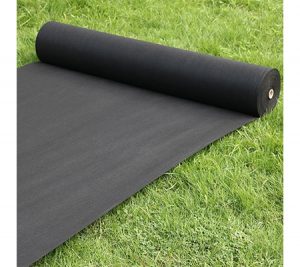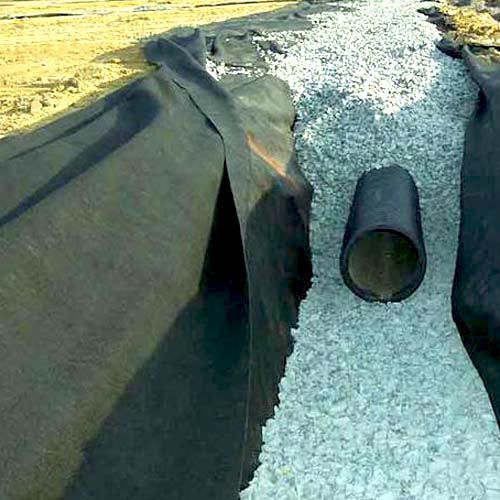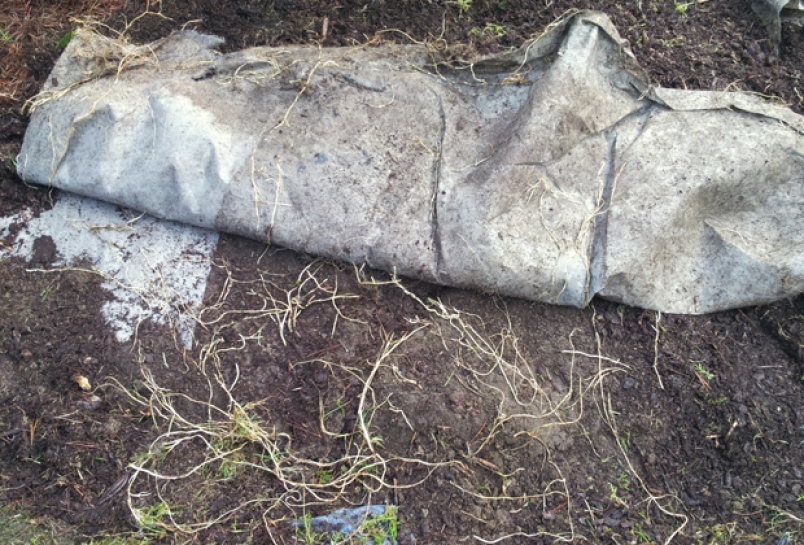Most people have probably seen or heard of landscape fabric here in Victoria BC. They are also known as filter fabric, permeable fabric, weed barrier, landscape cloth, and filter cloth. You’ve seen them in local big box home hardware stores and they are available in most construction retailers. They have been quite popular over the past couple of decades but there are many things most people don’t know.
What They Promise
The general impetus behind their use is that they promise to prevent weeds from coming up. They are to be used in a variety of applications including under patios, under walkways, under driveways, under mulch, and behind retaining walls. These products are promised as a relatively cheap and hassle free solution to prevent weeds from coming through end of story. You set it and forget it.

What They Actually Do
Their purpose and outcome are generally varied.
If they are installed under a paver surface such as a walkway or driveway or a patio, they are there to prevent weeds, for a little while. How long is a little while? It depends on the quality of the fabric, the quality of the install, and the nature of the existing root system. Generally speaking they should be good for 1-2 years. After that, weeds will start coming through due to roots breaking through as well as new seeds being deposited by birds, wind, and other dispersal pathways.
Sometimes in landscaping, they are installed for other purposes. For example, the word “filter” in filter fabric is supposed to filter out particulates. This is important when you want to maintain the consistency of your gravel. For example in a French Drain install, you do not want fine particulates to get into the pipe as it will clog it and render it ineffectual in short time. This is why we use clear crush, which is gravel with all the fine particulates filtered out, and then wrap it in filter cloth or landscaping fabric to let water through but not small particles of soil and sand. This is similarly used in retaining walls as well.
The Main Uses in Landscaping
In the landscaping profession in Victoria BC, landscaping fabric are used for 2 main purposes.
They are used as a weed barrier mostly because people have come to expect them regardless of their actual effectiveness. This is the case with a lot of landscapers here in town who do more maintenance work such as yearly mulching.
They are also used as alluded to above as a barrier to keep out particulates and keep good drainage. As mentioned again and again, drainage is one of the biggest issues we face in Victoria due to our heavy rainfalls. Poor drainage is one of the leading causes of structural failure in landscaping projects. That is why it’s essential to ensure there is good drainage. A drainage system will cease to function when it becomes clogged with particulates. The fabric works in conjunction with clear crush gravel to ensure long term health of the drainage system. Long term in this instance can mean over a decade.

The Cons of Fabric and Why They Fail
Besides the issue that they fail at their main purpose after only a year or two, the biggest downside is that they are a massive pain for future installs. Being a synthetic material, they don’t break down in the ground. So homeowners end up with these buried fabrics that act as a barrier to any future work. One might ask, well if they are still intact, how do they fail?
Besides the aforementioned seed carriers coming from above, e.g. birds, insects, wind, one has to explore the process of how nature infiltrates the fabric itself.
The fabric is woven in such a way to permit water through but not larger objects. This means there are holes in the fabric but it’s just too small for things like seeds and shoots to get through.
The problem arises in how roots and shoots grow. They push out cell by cell, which are tiny. The cells have no problems fitting through these holes. However, once they’ve established a beachhead, they push outwards as the plant structures become thicker. The fabric fibres are not designed to withstand such lateral forces from living organisms. This same mechanism is how roots can infiltrate rocks and concrete given enough time. It essentially wedges itself cell by cell. This is one of the primary mechanisms in which these fabrics all fail. Since roots love to seek out water, and there should be far more water below the fabric than above if one has proper drainage, the system promotes its own failure.

Conclusion
Like Polymeric Sand, here we have a product that’s been marketed very well but fails to deliver up to its expectations. While they should be used in the right applications, such as to filter out particulates to promote drainage, in many cases, they are an environmental disaster waiting to visit upon future generations. There are tens of thousands of these rolls being installed every year by landscapers in Victoria BC and homeowners. Their tattered remains will plague our soil for decades if not centuries to come.
When you contact us for a project, please let us know of your preferences for its use as a weed barrier.